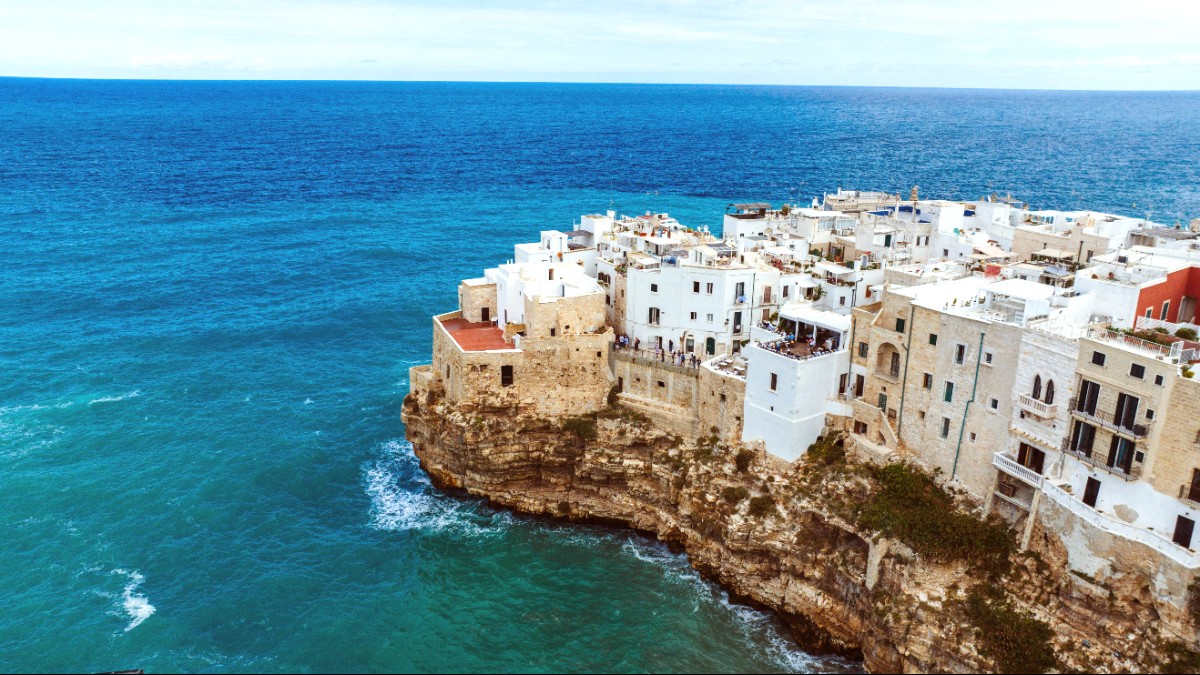
Puglia, Italy
From the iconic Lama Monachile beach nestled beneath a Roman bridge to the numerous sea caves carving into the coastline, Polignano a Mare presents a landscape that feels both dramatic and serene. This guide details a rewarding visit to this distinctive Italian destination. It helps uncover the town’s charm, experience its local culture, and maximize time along Puglia’s alluring coastline.
Lama Monachile beach and the Roman bridge in Polignano a Mare, an iconic view.
Step into Polignano a Mare, and immediately the Adriatic’s deep blue hues captivate attention. The town’s very foundation seems to defy gravity, with houses clinging to the edge of sheer limestone cliffs that plunge directly into the sea. Imagine strolling through a labyrinth of narrow, whitewashed alleys, each turn offering a new discovery: a blossoming bougainvillea, a quiet piazza, or a sudden, dramatic opening to the expanse of the sea below. Sunlight reflects off the white stone, giving the town a luminous quality, especially in the late afternoon. The air often carries the scent of salt and fresh seafood, mixed with the faint aroma of espresso from a bustling café.
This a town of daily life, blending with waves' constant murmur. A place for hours gazing at the horizon, watching fishing boats come and go, or observing local life unfold in town squares. The visual appeal undeniable, creating lasting memories for visitors. Beyond its picturesque appearance, Polignano a Mare a relaxed pace, for savoring each moment. A genuine taste of Apulian hospitality and the simple pleasures of coastal Italian living. For those seeking beauty, history, and an authentic regional experience, a grand yet intimate welcome awaits.
Deep blues of the sea.
White-washed buildings against sheer limestone.
Narrow, winding streets with discoveries.
Air carries coastal and coffee aromas.
Daily life blends with constant waves.
Polignano a Mare sits prominently on Italy’s southeastern coast, within the province of Bari, in the Puglia region. Puglia, often called the "heel of Italy’s boot," known for its long coastline, fertile plains, and distinctive architecture. Polignano a Mare itself an unique position along the Adriatic Sea. It rises majestically from dramatic limestone cliffs, a natural fortress against the waves. This geology shapes its character, forming numerous sea caves and grottos that dot the shoreline below the town. The town’s location places it roughly 35 kilometers (22 miles) south of Bari, the regional capital, easy travel for those flying into Bari Karol Wojtyłan Airport.
The surrounding landscape of Polignano a Mare typical of Puglia’s Murgia plateau, featuring gentle rolling hills blanketed with ancient olive groves. These silver-green trees stretch for miles, displaying the region's long agricultural heritage, specifically in olive oil production. The land gently slopes towards the coast, with small valleys or "lame" carving through the rock, leading down to hidden coves and pebble beaches. The most famous of these is Lama Monachile, directly beneath the town core.
To the south, the coastline continues with a mix of sandy stretches and rocky inlets, leading towards other charming towns like Monopoli and Ostuni. The sea here remarkably clear, often displaying shades of turquoise and emerald, for swimming and boat excursions. This blend shapes Polignano a Mare's special geographical appeal.
Polignano a Mare is a history as captivating as its dramatic cliffs, stretching back to ancient times. Evidence suggests a settlement here as early as the Neolithic period, settlers attracted by natural caves and strategic coastal position. However, the town’s documented origins trace to Greek influence, possibly founded as a Greek colony, though its name, Polignano, often links to the Roman "Neapolis" (new city) or "Polymnia." Roman presence visible, with the most visible remnant the impressive Roman bridge that still spans the Lama Monachile ravine, part of the ancient Via Traiana.
This bridge connected, aiding trade and movement along the Adriatic coast. During the Byzantine era, Polignano a Mare flourished as a center for trade and fishing, its fortified position offering defense against various invaders. Norman, Swabian, and Aragonese rulers followed, their architectural legacies remain within the town’s compact historic core. The Mother Church, for instance, built on the site of an earlier temple, underwent transformations reflecting these changing influences. Throughout these centuries, the town maintained its importance as a maritime hub, with its small port aiding commerce and cultural exchange. The narrow, winding alleys of the Centro Storico grew over centuries. These pathways once defended, confusing attackers. The town honors its past, notably through its association with Domenico Modugno, the famous singer-songwriter of "Volare," displaying the town's enduring inspiration.
Settlements since the Neolithic period, possibly Greek colony roots.
Visible Roman bridge, part of ancient Via Traiana.
Byzantine era flourish, Norman, Swabian, Aragonese rulers.
Polignano a Mare's history shaped by its strategic coastal position and maritime activity.
Dramatic cliffs, Lama Monachile, and Grotta Palazzese captivate.
Historic core, artisan shops, piazzas for exploration.
Fresh Adriatic seafood and flavorful Puglian ingredients.
Fresh seafood from the Adriatic and simple, flavorful Puglian ingredients define the culinary scene.
The region's ancient olive groves signify a long heritage in olive oil production.
A relaxed, welcoming atmosphere, characteristic of Southern Italy, with unhurried daily life.